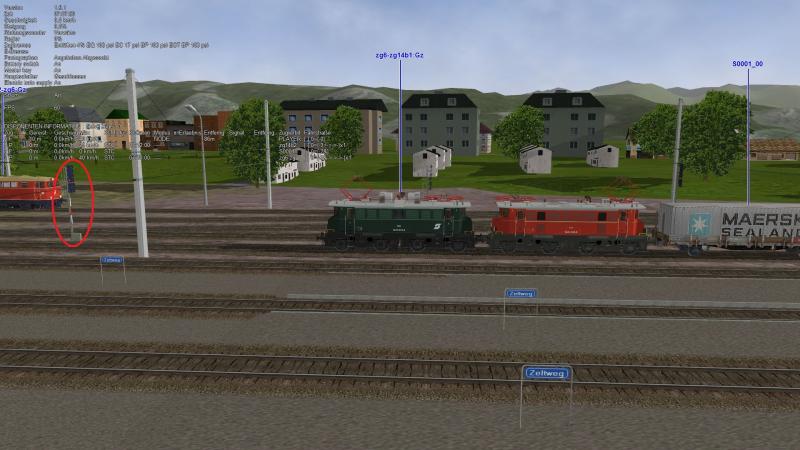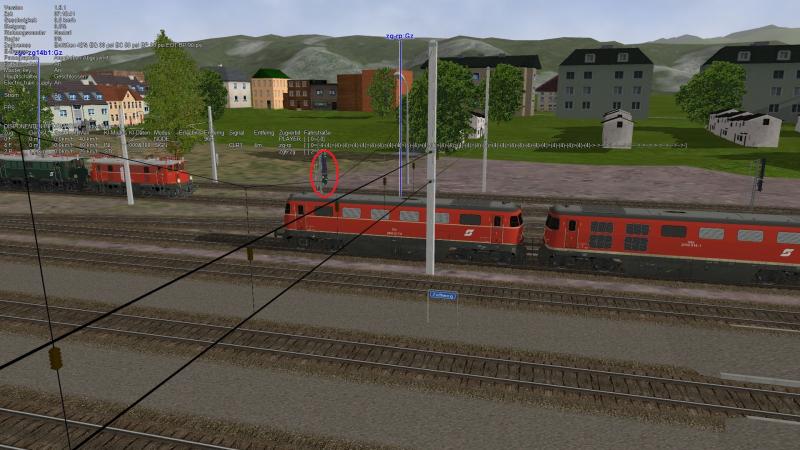Good evening,
in a timetable I intend a freight train to perform a change of locomotives. When arriving at the relevant location the train is hauled by a pair of electrics and it then should proceed towards a non-electric line, hauled by three diesel locomotives and supported by a helper locomotive on the rear.
Generally the timetable works as intended, but there is an exception: When the diesel locomotives attach in front of the freight wagons, there is only insufficient space between the freight wagons and the exit signal. I think it is because of the different length of the locomotives (arrival: 2 locomotives, departure: 3 locomotives, see screenshots, red marking is the exit signal).
I tried to change the ending of the arriving path, but instead the arriving freight train always stops near the exit signal, regardless to the ending of its path.
Is there any possibility to adjust that situation?
Regards,
Gro.Bi
Page 1 of 1
change of locomotives arriving train approaches too near to exit signal
#2

Posted 20 May 2023 - 11:08 AM
Hello.
I've asked quite the same question and the answer means: trains stop at the end of current node (switch or signal), no matter, where the end of path placed.
Try to learn about keepclear front commands and let's wait for Robert to come and comment this problem ac a concept author.
Good luck!
I've asked quite the same question and the answer means: trains stop at the end of current node (switch or signal), no matter, where the end of path placed.
Try to learn about keepclear front commands and let's wait for Robert to come and comment this problem ac a concept author.
Good luck!
#3

Posted 21 May 2023 - 02:56 AM
Hello,
I've read the documentation about $keepclear, but I am afraid that it is limited to platforms. A functionality independent of platforms would be desirable, e.g. $keepclear /front=<n> /signal, related to the next signal near the ending of the train's path.
I have tried to add $keepclear in the #dispose of the arriving freight train: $forms=zg6-zg14b1 $detach /nonpower /static $keepclear /front=20 /signal , but it has no effect, except in the Openrailslog the line Warning: Invalid dispose string defined for train kd-zg:Gz : keepclear.
So I have to wait if Rob maybe comments my request...
Regards,
Gro.Bi
I've read the documentation about $keepclear, but I am afraid that it is limited to platforms. A functionality independent of platforms would be desirable, e.g. $keepclear /front=<n> /signal, related to the next signal near the ending of the train's path.
I have tried to add $keepclear in the #dispose of the arriving freight train: $forms=zg6-zg14b1 $detach /nonpower /static $keepclear /front=20 /signal , but it has no effect, except in the Openrailslog the line Warning: Invalid dispose string defined for train kd-zg:Gz : keepclear.
So I have to wait if Rob maybe comments my request...
Regards,
Gro.Bi
#4

Posted 21 May 2023 - 04:28 AM
Yes, it works only with location markers (platforms ans sidings) indeed, but not with path ends and Dispose commands.
#5

Posted 21 May 2023 - 06:46 AM
I`m not sure if related, ( or if I understand correctly) but making a locomotive move to the extreme end of the track or path is important in a runround. Usually the switch for a runround has a short spur, maybe 20 metres. The in built safety margin in seems to prevent a loco from clearing the switch. because it stands off from the track end.
So do we need a $movetopathend command in the #dispose field ? Wouldn`t it cover the situations described by Gro.B and Weter , and my own runround spur?
So do we need a $movetopathend command in the #dispose field ? Wouldn`t it cover the situations described by Gro.B and Weter , and my own runround spur?
#6

Posted 21 May 2023 - 07:10 AM
Alas, Rick (Hello, by the way), as I understand, what Robert have said, block-section border is just a point, so the progran doesn't know, how long the switch model is. HOWEVER, theoretisally, why couldn't be needed clearance distance defined somehow in timetable commands?
#7

Posted 22 May 2023 - 11:39 AM
Hi Weter! I guess you could define a distance from a switch node in the timetable. I do not know if the clearance distance matters as written into the switch entry , t section.
But wouldn`t it just be easier to tell the locomotive to move to the very end of path? The person compiling and testing the time table is also wrtitng the path. So if you have a 15 meter loco and a 20 m spur after the switch, well you just end the path near the spur end. Same for the space required for gro.B signal.
With runround you often can`t extend the switch spur length because this would not fit a historic location.
But wouldn`t it just be easier to tell the locomotive to move to the very end of path? The person compiling and testing the time table is also wrtitng the path. So if you have a 15 meter loco and a 20 m spur after the switch, well you just end the path near the spur end. Same for the space required for gro.B signal.
With runround you often can`t extend the switch spur length because this would not fit a historic location.
#8

Posted 22 May 2023 - 07:14 PM
As I've understood, the path's end is just shows the block-section, where train path ends, when it comes to signaling*. Though, it works also as a location event, but only for triggering "activity" end event**. Therefore, during timetable run, only the first works, untill train termination case.
* No distinction, be that a switch point, dead end, crossover or signaling block boundary, so if train's "life" defined as being continued after complete usage of given path (forms another train, go stabling, runaround, etc.) it always moves up to current section's end. I.e. it's not a Path, who further defines train's movement, but entire block's length - untill the train will pass the new path's starting point. "Special paths" are just for that.
**
As I remember, in timetable mode train terminates just after stopping at the last station, when no further "dispose" commands present. While the path's end is being at some distance further (so in activity, train could travel some meters more after platform's end, for activity to be finished)
* No distinction, be that a switch point, dead end, crossover or signaling block boundary, so if train's "life" defined as being continued after complete usage of given path (forms another train, go stabling, runaround, etc.) it always moves up to current section's end. I.e. it's not a Path, who further defines train's movement, but entire block's length - untill the train will pass the new path's starting point. "Special paths" are just for that.
**
As I remember, in timetable mode train terminates just after stopping at the last station, when no further "dispose" commands present. While the path's end is being at some distance further (so in activity, train could travel some meters more after platform's end, for activity to be finished)
#9

Posted 26 May 2023 - 01:34 AM
It is true that a path is always extended to its logical end, that is the next signal, switch, crossover or end of track. Otherwise, one would have to be very careful and set the exact required position as end of path, also it could cause problems if the same path is used for trains of different lengths.
Although the two situations detailed above are quite different, it is clear that some manner in which an exact stop location can be detailed would be very useful. I will put this on my list.
Regards,
Rob Roeterdink
Although the two situations detailed above are quite different, it is clear that some manner in which an exact stop location can be detailed would be very useful. I will put this on my list.
Regards,
Rob Roeterdink
#10

Posted 26 May 2023 - 11:38 AM
Page 1 of 1

 Log In
Log In Register Now!
Register Now! Help
Help







